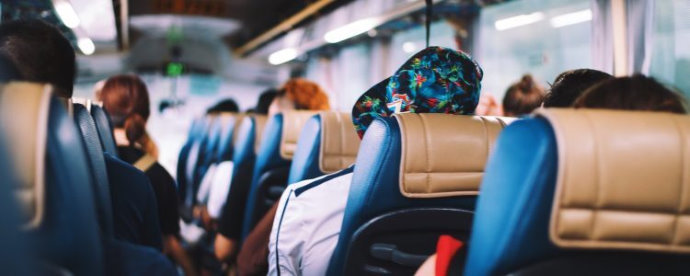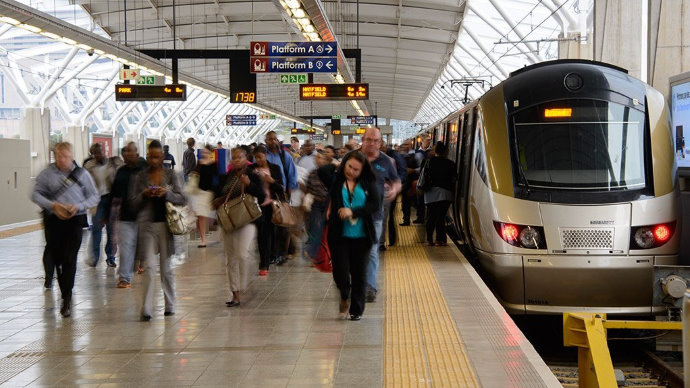Public transport is the mode of transport for most South Africans as well as the means of travel for many of our foreign visitors. Whether it is minibus taxis, trains, passenger buses, or aeroplanes, we need to recognize the importance of safety awareness when travelling with these vehicles.
Not only do we need to pay close attention to general safety rules, but also be attentive to averting the dangers of criminal activity such as theft, intimidation or gender-based violence.
In this section [while focusing mostly on road transport] Arrive Alive would like to consider some of the rights and obligations of both transport operators and commuters, while also offering some suggestions for safe travel!
What are the basic rights of commuters?
Public transport passengers have the right to:
- Freedom to choose the public transport mode or vehicle from those available that they would like to use, where this choice affects their safety.
- Safe public transport services and roadworthy vehicles.
- Drivers with a valid license and professional driving permits.
- Reliable services that transport them according to schedule or expectation.
- Travel on vehicles that are not overloaded or overcrowded.
- Professional and courteous treatment from the drivers and staff of all public transport operators.
- Travel on a public transport service without experiencing any form of harassment or discrimination.
- Transport services that provide value for money.
What should be expected from Public Transport Operators and their Passengers?
- Transport operators at all levels should maximise efforts to improve safety.
- Good road behaviour should include stopping at traffic signs, safe speed, safer following distance and not driving under the influence of alcohol.
- Taxi operators and bus operators must respect the rights of the passengers they transport from one place to another and commuters should be treated as contributors to social and economic development.
- Operators must ensure that their vehicles are driven by drivers who are medically fit to drive public passengers and are always in possession of valid professional driving permits.
- Drivers MUST pay attention to passenger safety, rights and respect passengers.
- Drivers must listen carefully to passenger complaints, identify problem areas and if appropriate take action to remedy the situation.
- It is also the responsibility of operators to prohibit drivers from harassing, intimidating or molesting passengers and to act against drivers who do so.
- Passengers have the responsibility to make sure that vehicles stop before boarding or alighting, pay the valid fare for the trip and show tickets for inspection when required.
- Commuters have the right to ask the driver not to exceed the number of passengers permitted to be carried in the vehicle or board a vehicle, which is overloaded.
Rules of the Road and Guidance from Public Transport Operators
- Always Obey the Rules of the Road
- Refrain from any criminal activity or carrying any illegal items in your baggage.
- If the vehicle is fitted with seatbelts – Wear them!
- Do not hang outside a train or let any part of your body protrude beyond the public transport vehicle.
- Obey the Safety Guidance and Regulations from the Operator – If prohibited from consuming food and liquor during the trip – Obey!
- Be focused on good hygiene for your safety and the safety of fellow commuters.
It is important to share some sound advice from the Automobile Association after the outbreak of the Coronavirus/ COVID-19:
“Road users who add to this pressure by not obeying the rules, and who through negligent actions cause crashes which require medical intervention, are adding to this pressure and are, quite frankly, selfish, irresponsible, and a danger to others. It is the responsibility of every person travelling to behave in such a way that their journeys are completed without incident,” says the AA.
Planning the Commute on Public Transport
- Establish before the journey which travel/ identification documentation would be required.
- Inquire about the payment method and the cost of the fare/ ticket for the journey to avoid carrying large amounts of cash.
- Ensure you are aware of the routes, timetables and estimated times of arrival.
- Maintain a schedule that ensures plenty of people are at your bus or train stop.
- Choose appropriate clothing and footwear for the journey with caution – This should be comfortable but not pose additional risks.
- Ensure that you have a fully charged cellular phone with you and alert family and friends of your progress and estimated time of arrival.
- Consider adding an emergency app on your smartphone for location tracking and easy access in an emergency.
- It is sound advice to carry a bottle of water with you for emergencies, thirst or dehydration.
Boarding Public Transport Vehicles
- Avoid using vehicles that are in a poor, non-roadworthy condition. Your safety depends on the state of the vehicle you choose to travel in.
- Avoid overcrowded vehicles or train compartments.
- Allow passengers to leave the vehicle before you attempt to board.
- If the vehicle is not close to the curb, be careful when climbing the first step because it may be higher than you realise.
- Board the vehicle one-at-a-time and try not to push.
- Passengers should exercise care when boarding or exiting the vehicle and use the handrail when ascending or descending steps.
- If you drop something, never go under or near the vehicle to retrieve papers or other objects. The driver may not be able to see you. Alert the driver and ask for assistance.
- During inclement weather, especially snow and ice, be careful and watch your step. It is wise to wear rubbers or boots at these times. They will not only keep your feet warm and dry, but they will add more traction that will help prevent slips and falls.
- Strollers should be folded prior to boarding. Always leave the vehicle with children in front of you, never behind you.

Courtesy to other Passengers on Public Transport Vehicles
Expect to share a small space with several passengers. You need to avoid conduct that could lead to a physical and verbal confrontation with other passengers, thereby endangering your safety, the safety of other passengers and distracting the driver.
- Be always courteous to both fellow passengers and the driver.
- The best passengers are the ones who tend to keep to themselves and quietly enjoy the ride home.
- Smoking will be prohibited on most passenger buses.
- Radios and tape recorders may be used for your listening pleasure, but earphones must be used, and the volume should be low enough so that others cannot hear it.
- Do not commit any act or engage in any behaviour that may cause harm, damage, or disturbance to any person or property.
- Refrain from having loud and/or vulgar conversations on the bus, including cellular phone conversations.
- Avoid unwanted conversation with other passengers tending to interfere with the other passengers’ use and enjoyment of the bus; or using obscene, threatening, offensive or “hate” speech.
- Do not throw things inside the bus. This could hurt other passengers or the driver.
- Report any suspicious items or activities immediately to the operator – Do not confront passengers on your own.
- Do not create unsanitary conditions on the buses or at bus stops.
- Help keep buses and bus stops clean by using trash and recycling receptacles.
Safety from Crime
- Be always alert and aware of your surroundings
- Avoid falling asleep on shorter commutes while using public transport, especially when travelling by yourself.
- If you are jostled in a crowd, be aware that pickpockets might also see an opportunity.
- Pay attention to the safekeeping of your wallet, keys and cellular phones.
- Do not be flashy in exposing valuables such as jewellery, expensive cellular phones and cash.
- Hold your purse tightly, close to your body. Keep your wallet in a front or inside coat pocket, or in a buttoned hip pocket.
- Even when on the bus, enjoy your ride but see to it that your purse or other belongings do not become unguarded.
- If you are travelling with small children, it is important that they are well supervised.
- To prevent separation from children, be sure to board together.
- If you are followed when you exit a vehicle/station, go to the nearest well-lit populated area, call the police or scream for help.

Safety when Disembarking Public Transport Vehicles
- The need for safety does not stop when the vehicle comes to a standstill! Many injuries occur through absent-mindedness and pedestrian distractions when disembarking the vehicle.
- Be ready to leave the vehicle before it arrives at the dedicated stop. – Don’t keep the driver and others waiting while you gather your belongings.
- Wait until the vehicle has come to a complete stop and the door has opened, before getting up from your seat.
- Wait until the people in the seats in front of you leave before you get up from your seat.
- Be sure to use the handrails when going down any steps.
- Be especially careful when stepping off the low step and onto the curb or street.
- After leaving the vehicle move quickly away from the vehicle and out of the danger zone.
- The most dangerous times of any bus trip is when you are outside of the bus.
- There is also the danger of passing cars when you must cross the street.
- If you intend to cross the street after you get off a bus, watch for traffic moving around the bus.
- If possible, go to the sidewalk and wait for the bus to leave the area.
- Cross streets only in designated crosswalks and be sure to obey all traffic signals.
- Children, even older ones can find it difficult to cross busy roads and are often seen crossing in front or behind the bus they have just got off.
- Do not cross the road from in front of a bus!

Public Transport, Ridesharing, E-Hailing and Mutual Respect
- Mutual respect of each other’s differences and boundaries is key.
- What we do or say, even with good intentions, may make someone feel uncomfortable.
- Riders and drivers may feel more vulnerable at night or when travelling alone.
- Conversations should be about general topics and not about asking for personal details.
- Actions such as staring, winking, or whistling should be avoided.
- It is inappropriate to comment on someone’s appearance, their sexual orientation, or their gender expression.
- It can be perceived as intrusive to ask for someone’s contact information or social media details.
- Ridesharing is not the place to flirt or proposition someone or engage in sexual conversations.
- Do not cross someone’s personal boundaries.
- Touching is very rarely appropriate and sexual touching is never ok.
- Users should never engage in sexual contact even if they know one another.











